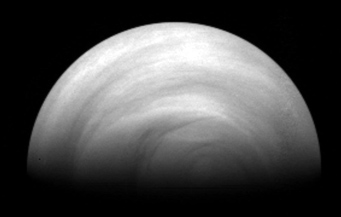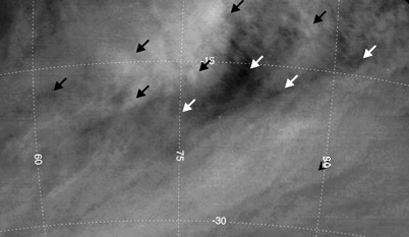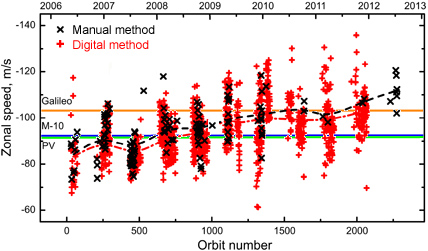On a planet that is already cloaked in mystery, long-term observations by Venus Express orbiter show that winds in the upper atmosphere are racing faster than ever.
What gives with Earth's nearest planetary neighbor? Sure, Venus looks bland and featureless when viewed through a telescope. (See for yourself: it's the unmistakably bright "star" low in the west after sunset.) But this veiled planet has challenged planetary scientists for decades.

An ultraviolet view of Venus's south pole, as recorded by ESA's Venus Express on May 15, 2006, when the spacecraft was about 41,500 miles (66,500 km) from the planet.
ESA / MPS
Fifty years ago, radar observations confirmed that Venus is rotating very, very slowly (once every 243 days) and backward (retrograde) with respect to Earth. Then, in the 1970s, passing spacecraft showed that the planet's mid-level atmosphere is racing ahead of the planet itself at hurricane-like speeds, swirling around in just about 4 days. The planet's clouds form distinctive chevron shapes, a combination of this superrotation and the slow migration of gas from the Sun-warmed equator to the cooler poles. No computer model has yet explained why the atmosphere moves so fast — let alone why Venus spins the way it does.
Now two independent research groups have found that the atmosphere's winds have been gradually speeding up for years. In 2006 the average velocity of the planet's cloudtops at low latitudes was about 180 miles per hour (80 m per second). But by 2012 it had risen to 250 mph (110 m/s) — a jump of more than a third in just 6 years.

Examples of cloud features identified in Venus Express images to monitor wind speeds. This image was recorded on October 27, 2008.
I. Khatuntsev & others / Icarus
This surprising discovery comes from long-term observation of cloud motions by a camera aboard the European Space Agency's Venus Express spacecraft, which maintains an elongated orbit that ranges in altitude from 150 miles (250 km) above the north pole to 41,000 miles (66,000 km) above the south pole. Over time its Venus Monitoring Camera has recorded thousands of images at ultraviolet and near-infrared wavelengths to reveal details in the topmost clouds roughly 44 and 38 miles (70 and 60 km) above the surface. The images were taken in clusters about every 100 days, whenever the spacecraft was positioned high above the planet's daylight hemisphere.
A team led by Igor V. Khatuntsev (Space Research Institute, Moscow) tracked 350,000 individual cloud features using a computerized identification program and another 45,000 by visual inspection. As they report in the planetary-science journal Icarus, speeds can vary a lot — even from one of the spacecraft's 24-hour-long orbits to the next. Also, the winds are typically faster over mid-latitudes than at the equator; the uppermost clouds take only 3 days to circle around in the mid-latitudes and up to 5 days above the equator.

The average cloudtop wind speeds on Venus between the equator and 50° north or south have increased by about a third over the first six years of the Venus Express mission. Black denotes data derived from manual cloud tracking, while red denotes digital tracking methods. Horizontal lines show values from the Galileo, Mariner 10, and Pioneer Venus observations.
I. Khatuntsev & others
But the winds' gradual strengthening over time was unexpected. "This is an enormous increase in the already high rotation rate of the atmosphere," Khatuntsev says in an ESA press release. "Such a large variation has never before been observed on Venus, and we do not yet understand why this occurred."
The second group, led by Toru Kouyama (National Institute of Advanced Industrial Science and Technology, Japan), used an automated cloud-tracking method for its analysis, which appeared earlier this year in Journal of Geophysical Research – Planets. The Kouyama team, which concentrated on images taken by Venus Express during its first 3½ years in orbit, finds that wind speeds vary by about 45 mph (20 m/s) in a cycle lasting about 250 days. This is longer than a Venus year (225 days), so it's probably not due to the varying intensity of sunlight during each orbit.
Notably, this isn't the first time the planet's wind velocities have wandered over time. Cloud tracking using Pioneer Venus Orbiter imagery revealed a slight slowdown from 1979 to 1982, followed by a quickening from 1982 to 1985.
But as the plot above shows, the top wind speeds derived from Venus Express are higher than those found at the same southern latitudes by any previous spacecraft — though they best Galileo's 1990 value only slightly. And since ESA's orbiter remains healthy and funded through 2014, it'll be interesting to see if the speeds continue to go up or come back down.
 5
5
Comments
Bruce
June 19, 2013 at 10:23 am
Well, isn’t it obvious? Venus is experiencing climate change due to CO2 induced runaway greenhouse effect. (The preceding is to be taken either seriously or facetiously, depending on your viewpoint.)
You must be logged in to post a comment.
Peter
June 19, 2013 at 4:32 pm
Guessing the change is oscillatory: wind speeds will fall.
You must be logged in to post a comment.
Bruce
June 23, 2013 at 2:49 pm
Yes Peter. If betting on whether a weather trend will change, always chose yes if the statement fails to include a time limit. This rule of thumb should work universally on all planets, provided that they orbit a star and have a substantial atmosphere. But betting on climate change would be far less of a sure thing. (Gamblers and potential gamblers beware; this tip is coming from a non-gambler. The only truly safe bets are those that are never wagered. Gambling has damaged countless lives, so I don’t want to come off as though I was recommending this practice.)
You must be logged in to post a comment.
Jim King
June 23, 2013 at 9:10 pm
Apparently they have yet to ban SUVs and CFCs on Venus. They also need to get moving on a Carbon Tax scheme as soon as possible.
Wait ...Could it be the rising output of the Sun that's causing temperature and weather changes throughout the solar system?
No? I'm sorry. I forgot that those who want to fundamentally change everything wouldn't like this discussion!
You must be logged in to post a comment.
Arlo James Barnes
October 15, 2013 at 11:13 pm
Ah comments sections, I can always rely on you to bring politics into even the most seemingly apolitical of discussions. While I appreciate that this metaphorically shows us that anything is up for debate, I will not partake beyond saying that any claim requires evidence to back it up (even this one, although you will sadly not get it from me right now), extraordinary ones all the more so.
But the fact that things important on a solar or planetary scale are happening within just parts of human lifetimes speaks (to me at least) of how amazing the universe sometimes shows itself to be. In tangentially related news, we found an 18 foot oarfish recently: http://bigstory.ap.org/article/18-foot-long-sea-creature-found-calif-coast
You must be logged in to post a comment.
You must be logged in to post a comment.